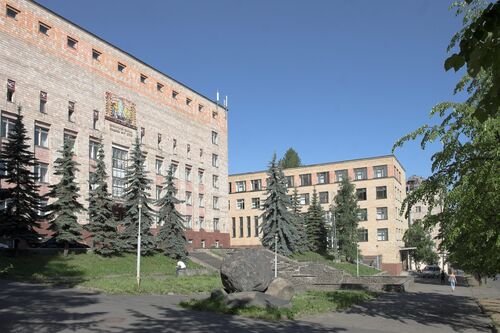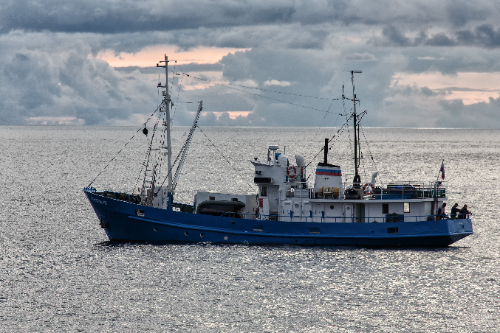There is a reason for choosing funeral rituals as the study object: they are the most change-resistant.
– Of all the life-cycle rituals accompanying birth, wedding, and seeing off recruits, funeral rites are the most conservative. Many traditional elements of burial and commemoration of the deceased are still practiced by inhabitants of Ludic villages, although not everyone can explain their meaning, - points out Sergey Minvaleev.
Karelian peasants started preparing for the transition to the netherworld long before death. For example, it was considered important to collect the cut fingernails and shed hair during one's life to be put in the coffin. They were believed to help the soul accomplish the arduous journey to the netherworld through steep mountains and deep gorges. Thus, studying the rituals is needed to comprehend our ancestors' world more thoroughly and to understand the processes in modern funeral rites.

Sergey Minvaleev at the grave of renowned tale-teller A.F. Nikiforova, Vohtozero village, Kondopoga District. Photo by Natalia Pellinen, 2024
In Soviet-time Karelian studies, which adhered to the atheistic approach and political agenda, the prevailing opinion was that most peasants were not religious and were reluctant to ask the Church for help in performing funeral rites. The approach of modern ethnology and anthropology is not so one-sided - adopting the “folk religion” standpoint. This is the term for a set of religious practices that exist among the people along with official religion formats.
– The folk religion integrates both mythology and a recasting of Church stuff. Unlike dogmatic religion, where everything is stable and normally not open to free interpretations, folk religion is flexible: it “lives”, adapts to the new conditions and is continuously transformed, – the scientist remarks.
A conclusion that Sergey Minvaleev drew from his research, including expeditions to Karelian villages, is that Ludic funeral and commemoration ritualism comprises a considerable stratum of Orthodox rituals. Church traditions supplemented the set of peasants' funeral myths and rituals and were blended with folk perceptions. This happened due to the well-developed Christian infrastructure in the Ludic territory and the compact Ludic population neighboring the Russian Orthodox population.

Stone church in the village of Belaya Gora, Kondopoga District. Photo from Sergey Minvaleev's archives
In particular, church attributes were used to dress the deceased for the funeral: the head was covered with a wreath, a paper with a prayer of absolution and an icon were placed in the hands. During the funeral, lamentations in Karelian were combined with prayers in Russian. The most common prayer was the Trisagion.
The scientist noted also that many aspects based in Christianity were given a new interpretation in the Ludic folk religion. For example, in the Orthodox doctrine, candles burning at the coffin symbolize the hope for the transition of the deceased to the realm of light - to a better afterlife. The lamp at the icon expresses “the love of favor to the one for whom the lamp is lit”. When holding burning candles at a funeral, Ludic Karelians believed that the deceased would also meet their souls after their death with a candle in their hand to illuminate their way to the afterworld. The Karelian funeral lamentations even called upon the deceased relatives to come “with burning wax candles to meet”.
– In fact, while dogmatic religion talks a lot about the salvation of the soul, about life after death, folk religion focused more on this world. For example, people confessed in order not to have their sins “'passed on” to the living or believed that “dying would be harsh” without confession. It was important to conduct the funeral ritual properly to help the soul cross over to the other world - if it stayed unsettled, it would torment the living, - said Sergey Minvaleev.
The key performers of the Ludic Karelian funeral ritual were the priest and local women that acted as washers and weepers. Villagers believed the performers had symbolic ties to the netherworld.

A grave with above-ground coffin-like structure (domovina) in Vlg. Ussuna, Kondopoga District. Photo by Sergey Minvaleev, 2021
There were also folk traditions such as making openings with glass at the head of the coffin. This custom was common also among the Segozero and Syamozero Karelians. People believed that the coffin was the dead person's home and was to be modeled as the “last dwelling” so that the deceased could “see” the living through the window.
The Orthodox burial ritual persisted through Soviet times, despite the state's struggle against religion. The main functions of the minister were taken over by religious elderly women. They ensured that Christian precepts were fulfilled, performed funeral prayers or their folk versions, and even fumigated the room and the grave with homemade censers, which can be seen at modern funerals too.
The results of the study were published in the international Journal of Ethnology and Folkloristics. The author remarks that it is the first step on the journey of anthropologically exploring the folk religion of Ludic Karelians.
Sergey Minvaleev's study is one of the components of comprehensive investigation of the history of Orthodoxy in Karelia conducted by staff of the Institute of Linguistics, Literature and History in connection with large-scale preparations for the celebration of the 800th anniversary of the Christianization of Karelians in 2027. One of its outputs will be publication of a multi-author monograph incorporating historical and cultural essays on Orthodoxy in our region.









